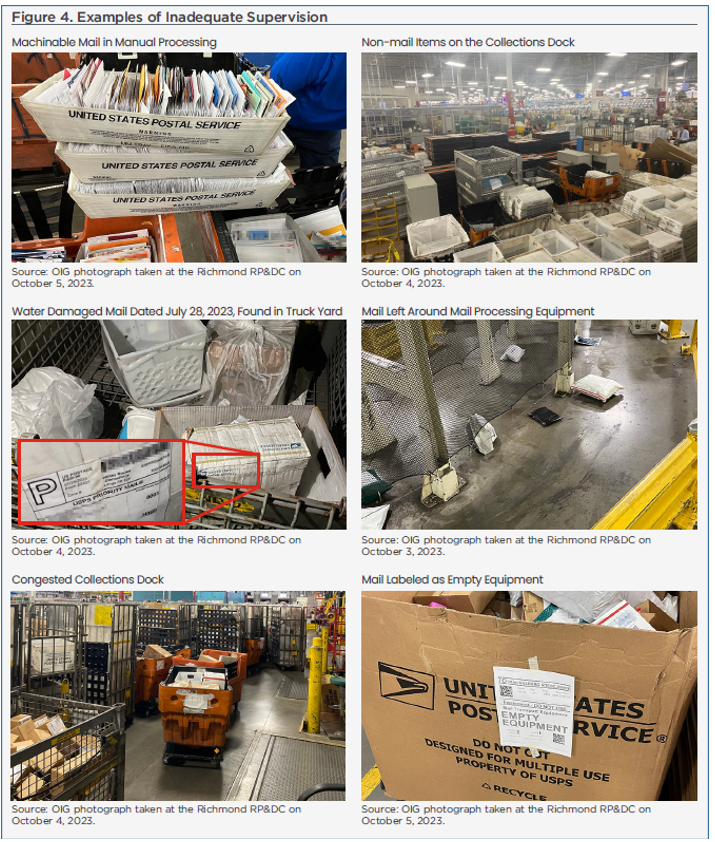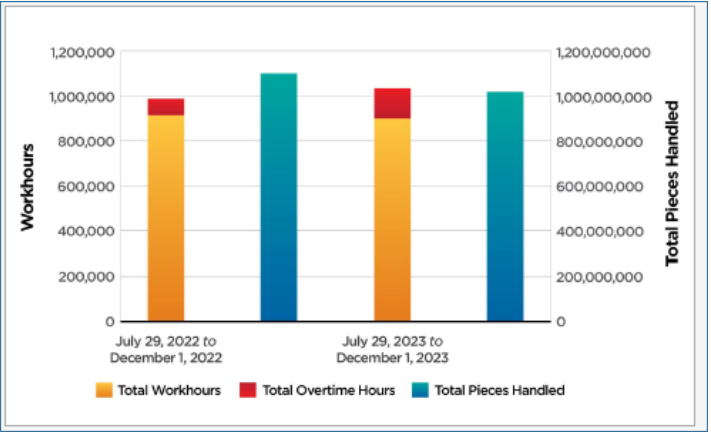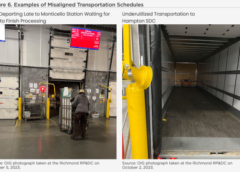As Postmaster General Louis DeJoy presses on with his Plan to transform the Postal Service’s collection, processing, transportation, and delivery networks, an audit of the first regional processing and distribution center opened under his Plan found a wide variety of problems.
The OIG summarized the transition of operations into the new RPDC:
“In July 2023, the Postal Service completed the consolidation of operations from package sortation annexes (PSA), P&DCs, and terminal handling services in the Richmond metro and Norfolk, VA, areas to the Richmond RP&DC. Then, in October 2023, the Postal Service executed the last of the planned operational moves when it consolidated mail processing operations from the Rocky Mount, NC, Processing and Distribution Facility (P&DF) into the Richmond RP&DC.
The audit, conducted by the Postal Service’s Office of Inspector General from July 29 to December 1 last year, had a simple objective: “to assess the operational impacts related to the launch of the RP&DC and identify successes, lessons learned, and opportunities.”
Findings
The audit report, Effectiveness of the New Regional Processing and Distribution Center in Richmond, VA, released March 28, presented five findings.
- “Finding #1: Successes and Lessons Learned from the Richmond RP&DC Launch. …The following are successes we observed during our site visits:
- Integrating Services. Mail processing operations for ZIP Codes beginning with 228 were transferred to the Northern Virginia P&DC, and the Richmond RP&DC absorbed operations for ZIP Codes beginning with 279 as planned. Additionally, the Richmond RP&DC absorbed package operations from the Norfolk P&DC, and the previously outsourced terminal handling services. Further, processing operation times and plans were changed to meet the needs of new S&DC and LPC facilities.
- High Output Package Sorter (HOPS). Two new HOPS machines were installed in March 2023 to meet future package capacity requirements. …
- Facility Layout. The Postal Service implemented a standardized workroom floor layout designed to provide an efficient mail flow throughout the facility. …
- Postal Service Lessons Learned from RP&DC Launch While the Postal Service had successes, management also identified several lessons learned. Specifically, management completed a post-implementation review 45 days after launch and identified the following as challenges when implementing its first RP&DC:
- The Postal Service did not complete several major activities in the implementation plan before launch, including: Finalizing machine sort plans, finalizing and validating transportation schedules, and identifying all post offices that have relationships with smaller post offices to send mail from and to the Richmond RP&DC.
- Local management didn’t take ownership of changes and were deficient in operational execution.
- Dock staging lanes were congested and hindered mail flow from processing machines.
- Staffing was not fully aligned to the new operating plan.
- Employee absenteeism increased after the launch.
- Management did not train all employees on standard work instructions for new processes.
- New processing equipment was not performing as expected in the first few weeks.
- Transportation schedules developed by the implementation team did not account for all local needs and staffing levels of the Richmond Region and required adjustments after launch.
These issues added costs from the use of overtime and additional transportation and contributed to the significant decrease in service performance scores. …”
- “Finding #2: Pre-existing Issues Not Fully Addressed Caused Challenges. The Postal Service did not take action to address known weaknesses before converting the Richmond P&DC into an RP&DC. OIG audits issued in 2021 and 2022 identified significant performance issues at the Richmond facility. These issues included inadequate management and employee staffing, low employee availability, high turnover, low service performance, missed clearance times, overcrowding, and low productivity.
- Plant leadership instability. We previously noted the management turnover rate was, on average, almost 10% each year, higher than the nationwide average. … However, during our review of the Richmond RP&DC, we noted there were three different plant managers in the four months since it launched. …
- Inadequate supervision. We previously noted newly promoted supervisors/ managers generally had not completed required training. … [D]uring our review of the Richmond RP&DC, we noted the Postal Service changed job descriptions for many manager and supervisor positions and some local managers and supervisors didn’t fully understand new operations and mail flow. We also observed multiple instances of personnel throughout the facility not engaged with work. For example, we witnessed idle terminal handling service staff waiting for mail, and in one instance, a mail handler sleeping on a parked forklift. We found a general inattention to detail that resulted in mail left on or around machines, large amounts of machinable mail in manual processing, and in one case, mail over two months old left in a container in the truck yard. We also observed clutter and congestion in many areas of the workroom floor and around the loading docks.
- Unauthorized overtime. Nearly 83% of all overtime hours at the facility since conversion (July 29, 2023, through December 1, 2023) were not authorized. … [M]anagement at the Richmond RP&DC did not approve 95,710 hours of overtime and 13,510 penalty overtime hours totaling over $5 million in questioned costs. …
- Inadequate staffing. … During our review of the Richmond RP&DC, we found staffing was not sufficient to effectively perform mail processing and transportation operations. Specifically, we observed: processing operations running without sufficient staff; a lack of postal vehicle operators, which did not allow the Postal Service to run all transportation needed to serve the Richmond region without outside contractors; and a lack of supervisors and expeditors and the inability to locate mail handlers on the workroom floor, causing delays on the dock and increased congestion.
- Service Performance. In our prior report, we noted deficiencies such as facility layout, overcrowded conditions, low employee availability and staffing, and inadequate management oversight contributed to the low service performance of the facility. … [T]he Richmond RP&DC experienced a significant decline in service performance following the launch attributable, in part, to issues and opportunities we identified. …
Selecting a facility without identifying and addressing known issues created additional challenges to successfully implementing the RP&DC model, increased costs, and contributed to the decrease in service performance. …”
- Finding #3: Inadequate Transportation Planning Affected Performance. As the Postal Service identified during its lessons learned review, we also found the Postal Service did not adequately plan and establish new transportation routes to support operations at the Richmond RP&DC. Specifically, headquarters and local management did not validate whether new transportation schedules were correct because the schedules were being adjusted the day before the launch, resulting in insufficient time to set up and make changes to routes. Further, the implementation team did not account for all local needs – such as mailer and commercial package pickups – when it developed the new transportation plan. Finally, the plan included less contractor transportation and more postal vehicle operators to transport mail; however, the Richmond RP&DC was not able to hire sufficient postal vehicle operators to cover the newly created routes. …
- As a result, all six key performance indicators that logistics management uses to evaluate transportation performance showed declines in performance. Specifically, when comparing the 18 weeks after launch of the Richmond RP&DC to the same period last year:
- Extra trips increased from 959 to 7,730 trips, or about 706 %
- Late trips increased from 17,478 to 22,770 trips, or about 30%
- Canceled trips increased 5,524 to 15,741 trips, or about 185%
- Unrecorded trips – trips that arrived or departed but were not completely recorded in the Postal Service’s tracking system – increased from 8 to 2,835 trips, or about 35,337%
- Trips departed, not arrived increased from 13 to 135 trips, or about 938%
- Trailer use decreased one percentage point from 54 to 53%
The Postal Service used extra trips to help bridge the gap between scheduled routes and operational needs. … The inadequate transportation planning and ongoing changes contributed to lower service performance and increased costs. … We estimate the Postal Service incurred over $3 million of questioned costs for the increased number of extra, late, and cancelled trips in the region from July 29 through December 1, 2023.
- Finding #4: Challenges Implementing the Integrated Operating Plan. Postal Service processing, transportation, and delivery managers at the Richmond RP&DC and supporting facilities did not always adhere to the regional integrated operating plan. … [D]uring our site visits, we identified the following examples of processing, transportation, and delivery operations not aligned to the new plan:
- Packages committed for delivery the next day required subsequent processing after operations were complete. … Operations ended at the same time for all machines and thus packages in these bins remained at the facility until operations resumed the next day.
- Package operations were shut down at the scheduled time for dispatch and any packages left on mail processing equipment remained at the facility until the operation resumed the next day.
- Packages arrived from other network facilities shortly after sorting operations finished for the day. These packages remained at the Richmond RP&DC until the next day when sorting operations resumed, and likely didn’t meet service goals.
- Collection mail arrived late, after sorting operations were finished for the day. This mail remained unprocessed until the following day.
- Collections mail arrived at the RP&DC without proper separation. This caused delays as mail was sent to incorrect operations.
Generally, these issues occurred because of numerous changes that were implemented after launch, inadequate coordination and communication with local management in developing and implementing the operating plan, and being the first region to experience these changes. Local management stated they didn’t fully understand mail flow within the RP&DC, weren’t aware of changes to transportation schedules until they happened, and that they weren’t solicited for input on the plan.


- Finding #5: Cost, Service and Customer Impacts After RP&DC Launch. The challenges the Postal Service experienced implementing its first RP&DC caused the Postal Service to incur additional labor and transportation costs and increased the risk that the Postal Service will not achieve expected savings. These challenges also contributed to a decrease in service performance for the Richmond region during the four months after launch. Additionally, the Richmond RP&DC operating plan does not support next day Priority Mail and required the Postal Service to extend the amount of time it takes to deliver that product.
Recommendations
The OIG offered ten recommendations:
- “… continue to document the issues identified and actions taken to address issues in post-implementation reviews of Regional Processing and Distribution Center (RP&DC) conversions, and use the cumulative lessons learned when activating future RP&DCs.
- “… develop procedures to identify and mitigate challenges at facilities scheduled to become a Regional Processing and Distribution Center before launch.
- “… coordinate the training of Richmond Regional Processing and Distribution Center (RP&DC) management on how to engage and lead team members and provide adequate supervision of operations, and deploy management training at future RP&DC sites prior to launch.
- “… develop a scorecard to track service performance and include it as a measure of success at both the Richmond Regional Processing and Distribution Center (RP&DC) and when implementing future RP&DCs.
- “… align transportation schedules to operations and validate with local management before launching Regional Processing and Distribution Centers.
- “… direct personnel to record omitted trips in the data systems and pursue recovery of payments for cancelled trips at the Richmond Regional Processing and Distribution Center.
- “… train all management personnel in the Richmond region to understand and perform their roles and responsibilities as stated in the Richmond Regional Processing and Distribution Center integrated operating plan.
- “… implement a process to communicate with and solicit feedback from affected managers when developing plans for and implementing future Regional Processing and Distribution Centers.
- “… update Handbook PO-408 to include the definition of service area, and clearly define when Mail Processing Facility Reviews are required.
- “… communicate any impacts to customers when permanently moving processing operations of a three-digit ZIP Code to another processing facility.
The OIG reported that
“Management generally agreed with the findings and recommendations but disagreed with recommendation 10, partially agreed with the monetary impact, and provided additional clarification for findings 4 and 5. …
“Regarding recommendation 10, management disagreed with the recommendation to the extent it presumes that moving processing operations in a single service area leads to service impacts. Management stated they will report service impacts to customers as appropriate. Management also stated the recommendation is ‘overbroad and unnecessary’ and would impede efficient operations. …”
In sum, the report paints a picture of a facility that was not doing particularly well already, being subjected to a poorly organized effort to remake its mission and operations, and not doing any better after.
Moreover, many observers might suspect that the deficiencies in Richmond – management turnover, ineffective supervision, poor work performance, inadequate adherence to operating plans, and a lack of training – are not unique to that facility, and that future RPDC implementations might not go any more smoothly if such shortcomings are not identified and remedied in advance.
Lastly, the OIG’s review suggests that the basic principles, tools, and methods of simple process management were absent. It’s hard to understand how a supposedly elite team of postal executives could prosecute as seemingly disorganized and fragmented a process as was done in Richmond.
Whether the PMG’s pressure to get it done, and his usual disinterest in feedback that might not agree with his perspective, were contributing factors is not known, but the apparent lack of deliberate and methodical action – and the lack of communication with local managers – would support such a supposition. The full 35-page report is available from the OIG’s website.
If you're on this page, it's likely because you have challenges to find solutions for or a question to answer. Fortunately, you've come to the right place. Click below to download our 2023 Services brochure to learn just how much we have to offer. Leave your name and email if you'd like us to stay in touch.
The brochure is a PDF that will open in a new browser window. Download, read, share, and let us know if you have questions.



